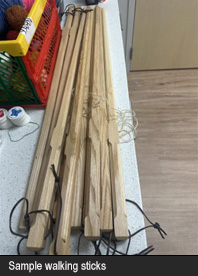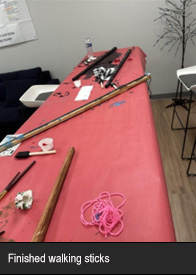Support on the Journey
Suggested Group(s): Teen/Adult
Purpose: This activity provides a creative and therapeutic outlet for grieving teens or adults to express their emotions, process their grief journey, and build resilience. The walking stick becomes a tangible symbol of their strength and the path they are navigating. It also allows for shared reflection and group support.
Task/need: Converting the relationship from presence to memory, relating loss to a context of meaning, living on the grief spiral, continued support
Activity Setup Ideas:
Activity Setup Ideas: Introduce the idea that each of them will have the opportunity to create a walking stick. They can decorate how they choose, in memory of their loved one and to honor their own unique journey. Below are suggestions to highlight during set-up while group members create the walking sticks. You may want to consider one theme of focus depending on your group’s needs (e.g. feelings, memories, support, grief journey, etc.)
- Support on the Journey — Just as a walking stick provides stability on a rough path, support from friends, family, or a community can help them navigate grief.
- Grief is Unique — The way they decorate their stick represents their unique journey. They might use colors, symbols, or words that reflect memories, emotions, or sources of strength. The way they decorate their stick can be a reminder that grief is personal. Everyone processes it differently, and there's no right or wrong way to grieve.
- Carrying Memories — The stick can symbolize carrying the love and memories of the person they lost as they move forward. They are not leaving their loved one behind but rather taking them along.
- Weathering the Elements — A walking stick endures different terrains and weather, just like grief comes in waves and changes over time.
- Marks of Experience — Some may choose to carve or mark their stick to represent milestones in their journey, showing how each step helps shape them.
- A Tool for Moving Forward — While grief can feel overwhelming, a walking stick is used for moving ahead, symbolizing their strength and resilience even when the path is hard.
Here are some prompts and questions to help guide their reflections as they decorate their walking sticks:
- Memory & Connection
- What colors, symbols, or designs remind you of your loved one?
- Is there a word or phrase that represents their impact on your life?
- If your loved one could leave you with a message for your journey ahead, what might it be?
- Strength & Support
- Who or what helps you when grief feels heavy? How can you represent that on your stick?
- What qualities (strength, resilience, hope, love) do you want to carry with you?
- If your grief journey were a path, what kind of terrain would it be (mountains, winding road, river, forest)? How does your walking stick help you navigate it?
- Growth & Moving Forward
- How has your grief journey changed you so far?
- What symbols or patterns could represent healing or hope for you?
- Imagine yourself in the future, looking back at this time. What would you want to remind yourself about your strength and progress?
Materials:
- Smooth wooden walking sticks (one per participant; variations in size/shape are fine), photo attached
- Acrylic paints (wide range of colors)
- Paintbrushes (various sizes)
- Sealer (to protect the paint)
- Beads, small stones, feathers, ribbons, etc. (for optional embellishments)
- Stickers
- Markers/Pens
- Small bowls/cups of water
- Paper towels/rags
- Aprons/drop cloths (to protect clothing)
- Optional: Mod Podge (for adhering embellishments), stencils
Description: Set up walking sticks and materials with plenty of space for participants to work on them. You may want to consider asking staff to use the community room for more space if needed. Allow time for participants to decorate their sticks, reflecting on their journey through symbolism. Walk around, offer gentle encouragement, support any who need guidance, and reassure all that individual choices in creative expression are individual and should remain non-judgmental and completely supported. The use of background music or nature background scenes can assist all participants in staying engaged in this safe space activity. Use suggested conversation prompts/discussion questions above during the activity.
Conclude with time for sharing, focusing on process (how the participants felt while creating) over product. It is fine for the participants to share at their discretion and preference. Remember the I Pass rule applies to everyone.
Activity Wrap Up Ideas: Reflection & Sharing (Optional, I-pass rule applies)
- Invite group members to share something about their walking stick's color, symbol, or word they included and why it's meaningful to them.
- Encourage them to reflect on the process: What was it like to create this? Did anything surprise you?
- Guided Visualization or Affirmation: have them close their eyes and picture themselves walking a path with their stick. Ask them to imagine feeling supported, carrying memories, and moving forward at their own pace.
- Share an affirmation, such as: Like this walking stick, you are strong enough to carry memories and move forward. Your grief is part of your story, but it does not define you. You are not alone on this path.
- Symbolic First Step: Encourage them to take a small step forward, holding their stick, as a symbol of continuing their journey with support, memories, and resilience.
- Closing Words End with gratitude for their openness and creativity. Remind them that, just as they've decorated their walking stick in a way that's personal to them, their grief journey is unique, and there's no "right" way to grieve.
Notes: Consider where group members are along their grief journeys before choosing a focus for the walking stick or using affirmations. This can be a good activity for ongoing groups.










